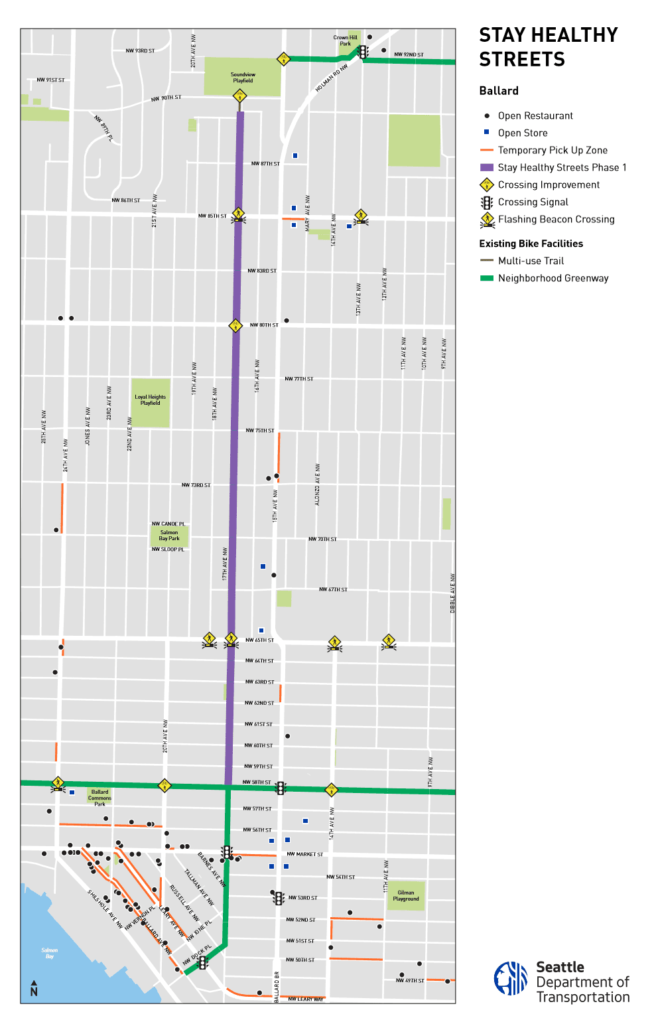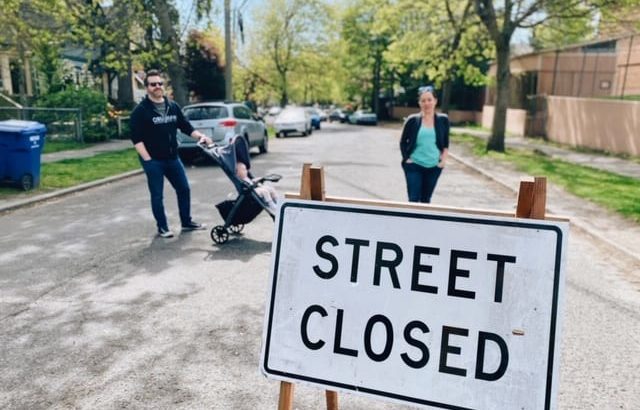Mayor Jenny Durkan announced Thursday that the 20 miles of Stay Healthy Streets established in the past couple weeks will be permanently closed to thru-traffic, including a section of 17th Ave NW in Ballard.
The Stay Healthy Streets program started in April, meant to help residents get outside during the COVID-19 stay-home order. The street closures block thru-traffic, while still allowing local traffic and deliveries. In Ballard, 17th Ave NW closed to thru-traffic this week between NW 58th St and NW 89th.
Now, the pilot program is becoming permanent, with all 20 miles of street closures set to usher in a “bold vision of enhanced bike infrastructure” in Seattle. Additionally, the City will begin to expand the program to include routes in more neighborhoods and accelerate more bike facilities, such as Neighborhood Greenways and protected bike lanes.

“We are in a marathon and not a sprint in our fight against COVID-19,” Mayor Jenny Durkan said in a statement. “As we assess how to make the changes that have kept us safe and healthy sustainable for the long term, we must ensure Seattle is rebuilding better than before. Stay Healthy Streets are an important tool for families in our neighborhoods to get outside, get some exercise and enjoy the nice weather. Over the long term, these streets will become treasured assets in our neighborhoods.”
SDOT explains that the street closures will add to the parks network in Seattle, providing more room for people to be outdoors safely. In addition to the street closures, SDOT plans to adjust nearly 800 traffic signals throughout Seattle to reduce the time people need to wait to cross the street.
The Stay Healthy Streets network expands today, with new routes established in Rainier Valley and near Alki.
SDOT is launching a survey next week to gather observations from residents, ideas for improving, and approaches for further expansion. In the meantime, you can send ideas and comments to SDOT at NorthSeattleGreenway@Seattle.gov.



As someone who lives next to 17th, this seems like a no brainer. It’s been great to see 17th so well used this past week!
“You never want a serious crisis to go to waste.”
– Rahm Emanuel
Funny, I drove across 17th last night twice at about 6 p.m. and there was one person on the street and one on the sidewalk.
Tired
So what happens when traffic returns to normal? It isn’t like we had any extra transportation capacity to begin with.
Perhaps just weekends and holidays would be a better compromise. Close the street when traffic levels are lower but open it during peak times.
Bicycles and pedestrians are traffic. Hopefully this proposal will encourage this corridor to be well used and reduce car traffic in general.
As a single lane residential street, 17th provides virtually no capacity for cars. Its capacity will not be missed by commuters, which will continue to use 15th.
“No through traffic” — the most ignored traffic sign in human history.
Whatever one thinks of the Governor’s emergency decrees, everybody assumes they are temporary and will be reversed or at least publicly discussed before becoming permanent.
Not so in Seattle. “Temporary” street closures quickly became “Permanent” during a time of lockdown. Why? Shouldn’t this decision wait until the temporary closures could be evaluated and post-shutdown effects considered openly and democratically?
Even those who like the decision should worry about its manner of enactment. Does anyone believe that SDOT was sincere when it recently called these changes “temporary”?
In case anyone trusts SDOT, drive to West Seattle and ask folks there. An informed public is at best a nuisance for SDOT.
You might not like the next disingenuous usurpation. Should we evaluate all “temporary” decrees as though they could soon become permanent?
Man you went from permanently restricting traffic on a residential street that already has partial permanent traffic restrictions to full on tin foil hat in 60 seconds flat!
More personal attacks against anyone who disagrees with you?
We’ve all seen it. It’s the Trump playbook.
You’re making sensationalist claims that we are going to permanently lose our rights, despite not stating which rights nor showing a shred of evidence to your claim.
You kind of attacked yourself by posting that, not unlike when Trump makes sensationalist claims on Twitter and claims bullying when people call him out.
🤔
Could we bicycle or bus to West Seattle instead? Now onto your point. You make some broad statements of mistrust in Seattle city government. While it is not my intent to defend any government I would still like to question why you feel that this decision was an overreach. Is there a city law that you think was violated or even some kind of precedent? The funny thing is that these are minor changes. They are really a public relations ploy to make bicyclists and pedestrians feel all warm and fuzzy while doing pretty much nothing.
I live on 17th and was never notified of any public meetings to see if the neighborhood wanted the closure. Not holding public meetings sure seems like overreach to me.
When developers put in new multi family buildings on Seattle streets that will and has increased traffic on my street; they either don’t have a public meeting or don’t pay any attention to comments about traffic at that meeting. They make that clear in the meeting, that comments about traffic, parking, noise etc. are not relevant. This is at multiple public meetings.
@ Western Girl:
The decision to make the temporary decision permanent was wholly premature. It should have waited until full public participation becomes legal once again.
Governor Inslee has decreed that City Council business should be limited to routine matters and those necessary to fight COVID-19. Permanent closure of miles of public streets is not routine. Perhaps the temporary closures are beneficial in controlling the virus. Making them permanent past the emergency does nothing to fight the virus after it has been contained.
Is Council acquiescence in this decision a violation of the Governor’s order? Perhaps we’ll find out. If it is merely a gesture to make bicyclists happy while less-favored interests are annoyed, as you suggest, it’s demagoguery.
If ya can’t beat them on substance, fight on process! Good luck!
It’s all about the process.
I don’t use that stretch of 17th except to cross it, but I can only guess what undisclosed schemes SDOT has in store for other streets. A Seattle Times story says Magnolia Boulevard could get this treatment. What’s to stop them?
There is no reason to make these temporary changes permanent now. Personal insults are no substitute.
Simmer down there. There were no “personal insults” in my post to you above, snowflake. The form of government that we have in the United States is called a “Republic.” In our form of government, we don’t vote individually on every little issue that arises. Instead, we elect officials and employ administrators who legislate and execute the laws. If you find this does not comport with law, you have the privilege of taking the matter to the courts. It’s called freedom – give it a shot!
Great thanks for your response, but other than you thinking it is premature, I don’t see any basis for your claim. As I pointed out elsewhere, there has never been any public participation to comment on increasing motor vehicle traffic yet that has happened. Why do we need public participation to decrease motor vehicle traffic, back to say 2005 levels? Governor Inslee doesn’t control the city at the level that you imply. Seattle can still do business. Just because you don’t like it doesn’t mean it is overreach. As to “routine”, what defines that? Streets get closed for months for construction projects. The world is changing and new responses are needed to adjust and make the city better. I’m glad that the mayor is willing to take a chance and try out something new that has the potential to help a lot of Seattleites and I don’t know of any law or process that disallows her from taking this action. As to collecting public opinion, I’m sure that can be done anyway and not sure that any existing processes to do so (short of actual elections) are fair. You can express your point of view to the council. Go for it with both hands! If you live here….
But that’s my go to drive up mailbox. Dammit.
I hope they relocated that mail box.
I love having 17th re-purposed this way but I will miss that mail box.
The Mailbox is 57th.
Was it moved? Last month it was on 17th.
that section of 17th is not part of the stay healthy street
Great. Profiting off of a pandemic. The only reason this was accepted (if it actually was accepted by the ENTIRE Seattle population) was due to the need to “sacrifice” for the good of the public. But the Mayor, who doesn’t live in the City and doesn’t need to worry about driving around the City, forces a policy decision during a time when policies like this should not be made. “No Thru Traffic” in any neighborhood street, just erodes those areas that No Thru Traffic are really needed. Nope, won’t pay attention to it. ITS CALLED A CITY, YOU CHOOSE TO LIVE HERE.
Like most things this city does, this will look good on paper, and nothing else more. Who’s going to be policing whether a car uses 17th for through traffic instead on local use. No one. I guarantee there will not be a single infraction issued for driving on this street once it’s “closed.” Not going to happen, ever! Can you imagine contesting this in traffic court and having the city have to prove you weren’t dropping something off at someone’s house, i.e. a “local delivery.”
Try going to 17th on a nice day and see for yourself. It’s pretty much self-policing with the number of people walking and biking in the middle of the street.
Nice to see you advocating for ripping up the asphalt, even if I think that is a bit of an extreme opinion.
Have lived on 17th NW for the past couple decades. The noise level has greatly increased in the past week. Sense of safety and peace has greatly decreased. Afraid small crimes, such as packages being stolen off porch, dog mess left in the yard, and car break ins, will eventually increase. Hope this at least helps increase property values, because I may be forced to move.
You’re being a bit dramatic. Cars are louder than people. Say hi to your neighbors, they are probably kinder then you think they are. Package theft is typically done with the assistance of a car because you only have so many hands to carry your ill-gotten gains. Dog poop isn’t a crime, it’s an inconvenience. I would think increased foot traffic would disincentive car break-ins, but please illuminate me if you have an explanation for how the opposite would happen.
@ Aurox. I’m not complaining. I love that 17th is closed to through traffic, but kai1 is correct. Bikers are surprisingly loud when riding together and shouting to communicate to each other. The rise in neighborhood children biking and playing in/around the street are noisy also. Yes, cars are louder, but 17th always had relatively few cars due to the speed bumps. It’s definitely noisier on 17th now, at least on sunny weekends. (And I love it.)
If you are going to make a private road out of it make the occupants pay for maintenance and repairs. I don’t want my tax dollars paying for someone else’s road that I cannot use.
Except, the occupants didn’t vote for it (weren’t given a chance to, it was forced upon us) and certainly many using it for recreation don’t live on 17th. Otherwise, I think it’s a good point.
Per above, in our form of government, we don’t vote individually on every little issue that arises (i.e., how to manage city side streets). Instead, we elect officials and employ administrators who legislate and execute laws and regulations. If you find this does not comport with law, you have the privilege of taking the matter to the courts. Or you can vote the bums out. Those, my friend, are your remedies. Best of luck!
We are not in normal times.
The First Amendment is partially suspended.
Gubernatorial Proclamations 20-05 and 20-28.
This is acceptable because it is temporary and limited. If instead local governments use the emergency to make permanent changes public mistrust will rise, which in these circumstances is dangerous.
I ask again: why should these temporary street closures be made permanent before the emergency ends?
First, let’s deal with the fake news: the First Amendment is not “partially suspended.” Is there tension between the governor’s proclamations and the Bill of Rights? Sure. The legal analysis rests on whether the governor’s restrictions would pass the strict scrutiny test. We don’t have time for that analysis here, so you’ll just have to look it up on your own.
All of your other concerns are valid and should be asked of local officials. But to call it “demagoguery” (a misused term above – try using the word “fascist” next time) is a gross misrepresentation. Can you write an op-ed or post about it on a local neighborhood blog until you’re blue in the face? Yes. Could you sue the City for the overreach? Sure. Would you win? Maybe – courts get to decide what the law is. Can you vote them out of office. Yes.
You are welcome to walk it, bike it, skate it, rollerblade it, etc…
I have noticed many online tool sites that are available to know your clicking speed by Kohi Minecraft server. There is a difference!! the Clickspeedtest.info is a web application that will help you to check your Kohi Clicker Test the same way.